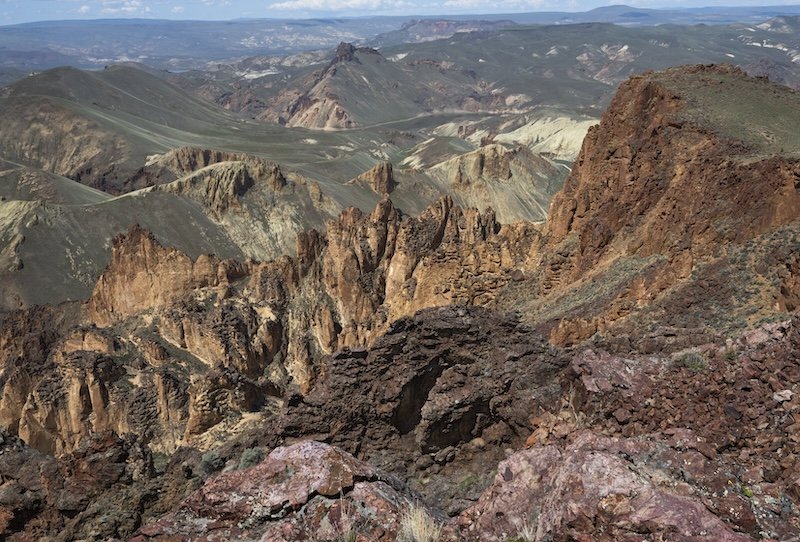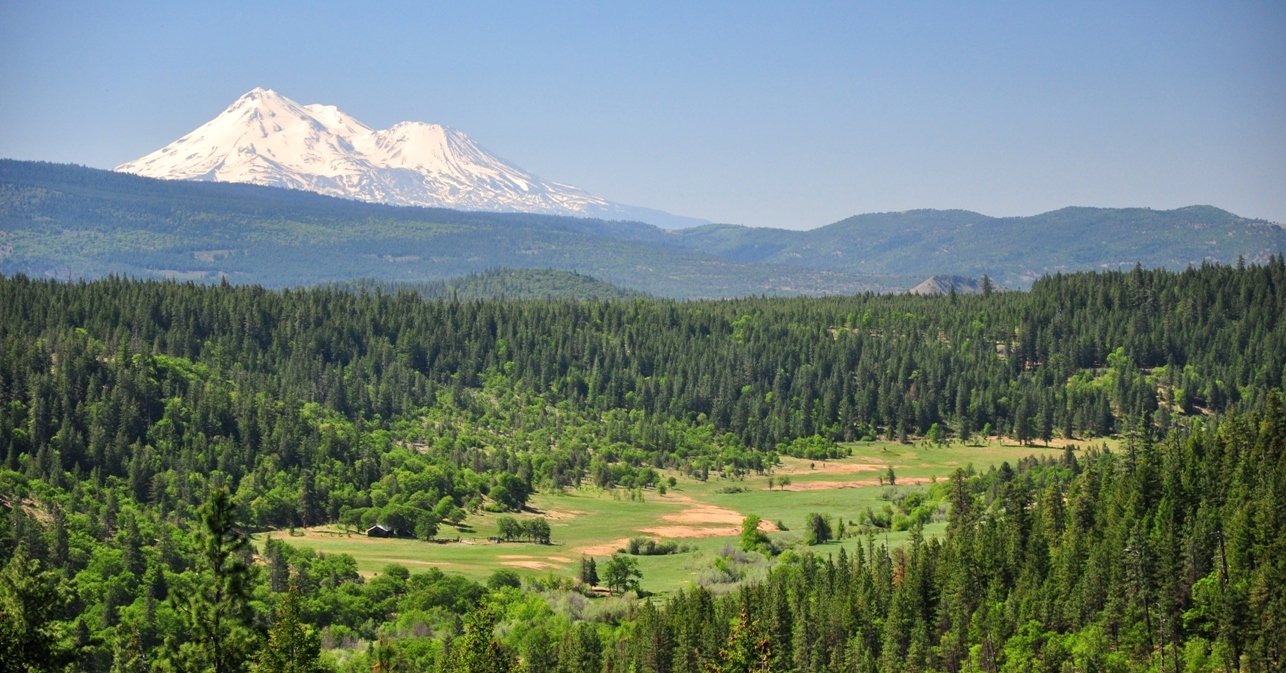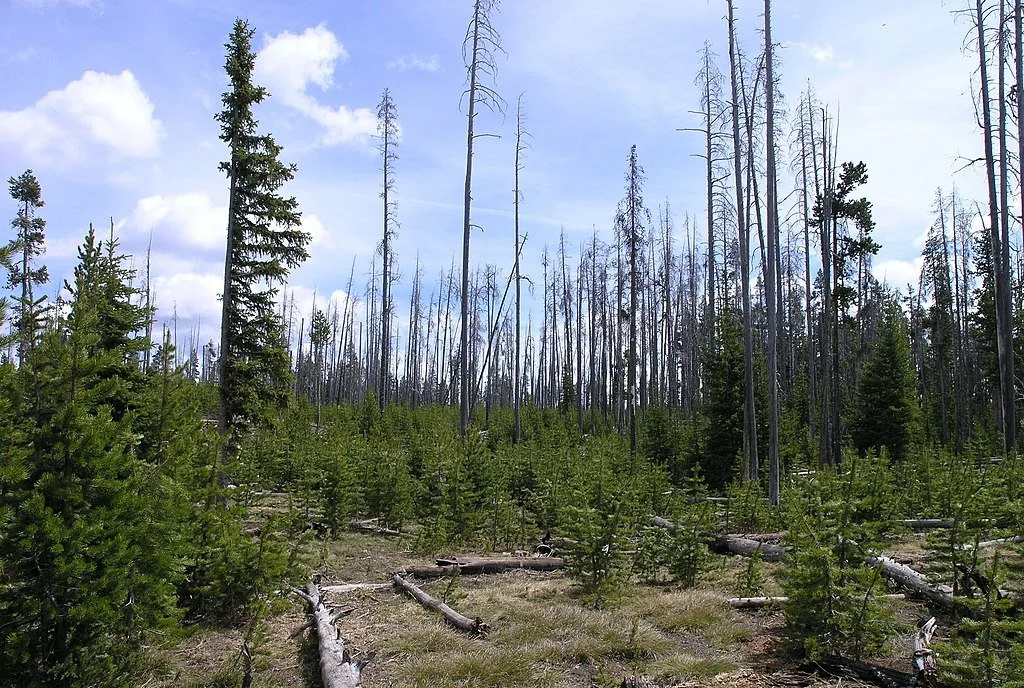Top Line: Senator Wyden is cosponsoring legislation that would give blank checks and get-out-of-jail-free cards to all BLM grazing permittees and lessees.
Figure 1. A bovine on public lands crapping in the same stream from which it drinks. In the absence of domestic livestock, this stream would be colder and deeper, well shaded by willows if not also cottonwoods, and likely full of trout. Source: George Wuerthner.
Senator Ron Wyden (D-OR) is the sole cosponsor of a bill by Senator John Barrasso (R-WY) that would give Bureau of Land Management (BLM) grazing permittees and lessees even more free rein than they have now to (ab)use the public lands. The Barrasso-Wyden bill, the Operational Flexibility Grazing Management Program Act (S.4454, 118th Congress), would effectively remove any administrative control the BLM has over the grazing of livestock on 155 million acres of federal public lands.
As a senator from Wyoming, Barrasso has long carried any and all water requested of him by public lands grazing permittees and lessees. The Barrasso-Wyden bill is the latest in a long line.
Wyden’s Proposed Owyhee Canyonlands Bill: Quid Pro Quo
This is not Wyden’s first legislative attempt on behalf of grazing “flexibility.”
For the past several years, Senator Wyden and his staff have labored long and hard to bring forth legislation to address public land management issues in Malheur County, Oregon. The latest incarnation of his Malheur Community Empowerment for the Owyhee Act, would primarily do two things on BLM holdings in Malheur County:
• Establish ~1.1 million acres of new wilderness areas.
• Authorize “flexible” livestock grazing on BLM lands in Malheur County.
The bill would do other things, but most of the verbiage pertains to wilderness and livestock grazing.
Wyden’s bill proposing a wilderness–livestock grazing grand bargain in the Owyhee Canyonlands (S.1890; 118th Congress), was introduced in the Senate in June 2023, reported out of the Energy and Natural Resources Committee in December 2023. A vote of the full Senate has not been scheduled. Most, but not all, of the conservation community supports S.1890 and they feel it is—despite a grazing “flexibility” provision—a significant net gain for public lands conservation.
Figure 2. Land near Kemmerer, Wyoming. On one side of the fence, the land is ungrazed. Guess which side. Source: George Wuerthner.
Here are two political givens:
• Conservationists love wilderness and hate livestock grazing.
• Public lands ranchers love livestock grazing and hate wilderness.
However, there is a place where these two sets overlap (picture a Venn diagram), and Wyden has found it in his Owyhee bill. Public lands ranchers really want “flexibility” language and are willing to give 1.1 million acres of wilderness to get it. Conservationists really want 1.1 million acres of wilderness and are willing to give a carefully worded and constrained version of grazing “flexibility.”
In the crafting and politics of legislation, such is known as a quid pro quo. One faction gets something they want more by accepting something they want less. Happens all the time.
The proposed wilderness boundaries and grazing language were long debated and fought over, but Wyden’s latest bill seems to thread a political needle.
In cosponsoring S.4454, Wyden has tossed aside the delicate compromise offered in his Owyhee legislation and embraced a unilateral and far more damaging giveaway to the public lands livestock industry.
Figure 3. Livestock in the Sonoran Desert National Monument in Arizona. Source: George Wuerthner.
The Entrails of the Barrasso-Wyden Bill: Quid Pro Nihilo
“Flexible” grazing is not bovines practicing their yoga cow pose.
It would be bad enough if Wyden had taken his Owyhee “flexibility” language national and offered it without any corresponding conservation (a.k.a. “wilderness”) offset. However, the Barrasso-Wyden (national) “flexibility” language is arguably ten times worse in effect than the Wyden (Owyhee) “flexibility” language.
The Wyden (Owyhee) version of “flexible” grazing contains sideboards and leaves public lands managers with their ability to manage grazing on public lands. The Barrasso-Wyden (national) version of “flexible” grazing means that public lands ranchers get to do even more of what they want on public lands, with the public lands managers no longer having a say, with no analysis and stewardship requirements.
The Barrasso-Wyden (national) “flexibility” language is a total giveaway of blank checks and get-out-of-jail-free cards to grazing permittees and lessees on public lands administered by the BLM.
Figure 4. Livestock near the Paria River in the Grand Staircase–Escalante National Monument in Utah. I honestly don’t know what they are eating. Source: George Wuerthner.
The public policy director for the Western Watersheds Project (WWP), Josh Osher (my go-to guy for all matters of public lands grazing policy), submitted testimony (on behalf also of Kettle Range Conservation, Oregon Natural Desert Association, Public Employees for Environmental Responsibility, and Wilderness Watch) in opposition to the Barrasso-Wyden bill (WWP et al.). The bottom line:
S. 4454 is an attempted end around to virtually eliminate NEPA requirements and public involvement in grazing management on public lands. This bill puts all of the power in the permittee’s hands and removes nearly all discretion from the Secretary to manage grazed lands for multiple use. Passage of S. 4454 would lead to continued failure of BLM managed lands to meet even the most basic standards for land health and eliminate the few remaining tools at the BLM’s discretion to address problematic livestock grazing. [emphasis added]
How does the Barrasso-Wyden (national) “flexibility” language compare to the Wyden (Owyhee) “flexibility” language? The WWP letter notes:
Furthermore, this legislation is a significant departure from the current pilot program initiated by the BLM and the operational flexibility language in S. 1890, the Malheur Community Empowerment for the Owyhee Act. S. 4454 dramatically expands the purposes for modifying the terms and conditions of grazing permit from responses to environmental factors and ecological conditions to now include producer preferences and responsiveness to market conditions. [emphasis added]
The Barrasso-Wyden “flexibility” language would make a complete sham of the National Environmental Policy Act (NEPA) by requiring the BLM to always choose the “flexible” grazing alternative. The WWP letter notes:
The bill language states that the “Secretary shall develop and authorize at least 1 alternative” for operational flexibility. It is unclear if “authorize” means that alternative must be chosen or simply analyzed with the discretion remaining with the Secretary to determine which alternative to implement. If the former, this a complete usurpation of the Secretary’s authority to manage public lands according to multiple use principles. [emphasis in original]
The WWP letter further notes:
The final section that prohibits termination of a grazing permit due to the use of operational flexibility functions to fully insulate the permittee from any consequences of bad management choices for which the Secretary had no discretion to modify or deny. [emphasis added]
In reading legislation, I always try to follow two principles:
• Read the language as if you are paranoid. Read the language in a way that the forces of darkness could/would interpret it if they were in charge. Just because one is paranoid, it doesn’t mean that one is not being followed.
• Clearly discern what is being done for you and what is being done to you in the legislative language. The Barrasso-Wyden bill is all the latter and none of the former.
Rather than an acceptable quid pro quo, the Barrasso-Wyden “flexibility” language is a quid pro nihilo (something for nothing). Something for public lands ranchers, nothing for conservationists.
Figure 5. Livestock in the Eagletail Mountains in Arizona. Source: George Wuerthner.
A Benign Bovine: No Such Animal
Let’s take a moment to remind ourselves why livestock production—especially on public lands—is problematic.
Domestic livestock have done, and are doing, more damage to Earth than the chainsaw and bulldozer combined.
Livestock production—primarily cows—accounts for 14.5 percent of global greenhouse gas emissions (a few sources say less, most sources say more), most in the form of methane emitted by belching bovines. A molecule of methane has a global warming potential at least 28 times greater than that of a molecule of carbon dioxide. Animal agriculture also produces 65 percent of the world’s emissions of nitrous oxide (yes, laughing gas, but no laughing matter here), which has a global warming potential 296 times greater than that of carbon dioxide. In addition, 70 percent of the world’s agricultural lands are dedicated to livestock—lands that were formerly forests, grasslands, and/or wetlands.
Locally—and most especially on public lands—livestock cause chronic and grievous environmental harm. Most streams flowing through public lands have been cow-bombed to such an extent that water quality is horrendous and water quantity is diminished.
Figure 6. Fresh cow shit on rocks in a stream on public lands. If it were deposited on land, many would call it a cow pie. I do not. Unlike pie, cow shit is neither sweet nor savory. Source: George Wuerthner.
The public land forage now consumed by one cow and one calf could be allocated instead to sustain either one bison, seven to eight deer, more than two elk, nearly eleven pronghorn, nearly seven bighorn sheep, or more than one moose—not to mention that it could serve as hiding cover for sage-grouse and a buffet for butterflies and other pollinators.
Fewer domestic livestock on public lands would mean fewer wolves killed to protect livestock.
As a fraction of the nation’s beef supply, the contribution of public lands is very minor, and the market wouldn’t miss anything if livestock grazing ended on public lands.
Figure 7. Livestock near Beatty Butte in Oregon. The average full-grown cow (left) weighs ~1,400 pounds. On BLM land, the calves dine for free. Source: George Wuerthner.
A Fair Quid for the Quo
In Wyden’s Owyhee bill, the price local public lands ranchers would to pay for their “flexible” grazing language is 1.1 million acres of wilderness. In the Barrasso-Wyden flexible grazing bill, the price public lands ranchers have to pay is nada, zero, zip, zilch.
Were the Wyden site-specific (Owyhee) quid pro quo expanded nationally in the same proportion, public lands ranchers would have to accept 34,937,664 acres (but who’s counting?) of new wilderness areas. However, the Barrasso-Wyden (national) “flexibility” language is at least ten times worse than the Wyden (Owyhee) “flexibility” language, so make that 349,376,649 acres of new congressional conservation designations.
Alternatively, the quid for the quo (or the quo for the quid, depending upon your point of view) could be a new title for S.4454 that provides for a nationwide voluntary grazing permit relinquishment program. (See my three Public Lands Blog posts on the subject under “For More Information” below.) There is such legislation pending in the House of Representatives, the Voluntary Grazing Permit Retirement Act (H.R.6314, 118th Congress). Wyden has successfully legislated voluntary grazing permit retirement language in legislation establishing the Soda Mountain Wilderness and expanding the Oregon Caves National Monument.
If I were one of those twenty-two elite federal grazing permittees in Malheur County, I’d be urging my buds to walk away from Wyden’s wilderness–flexible grazing bill and run toward his national flexible grazing bill. Why pay when one doesn’t have to? Especially since it would be ten times better at zero cost.
The Wyden (Owyhee) “flexible” grazing language is acceptable to much of the conservation community in the context of a quid pro quo for wilderness designation. The Barrasso-Wyden “flexible” grazing language is not accompanied by even 1 acre of congressional conservation designations such as wilderness, national monuments, national parks, national wildlife refuges, or national conservation areas. Wyden should walk away from this quid pro nihilo.
Figure 8. Livestock in the Agua Fria (“Cold Water”) National Monument in Arizona. To an untrained eye, the foreground might look “natural.” Actually, it is quite cow-bombed. Source: George Wuerthner.
For More Information
Kerr, Andy. December 2, 2016. A Federal Public Lands Grazing “Right”: No Such Animal. Public Lands Blog.
———. May 26, 2017. The High Cost of Cheap Grazing. Public Lands Blog.
———. August 13, 2021. Where’s the Beef? Public Lands Blog.
———. October 3, 2022. Senator Wyden’s Owyhee Wilderness, and More, Legislation. Public Lands Blog.
———. September 4, 2023. Retiring Grazing Permits, Part 1: Context and Case for the Voluntary Retirement Option. Public Lands Blog.
———. September 12, 2023. Retiring Grazing Permits, Part 2: History of the Voluntary Retirement Option. Public Lands Blog.
———. September 12, 2023. Retiring Grazing Permits, Part 3: Future of the Voluntary Retirement Option. Public Lands Blog.
Western Watersheds Project et al. June 26, 2024. Letter to Subcommittee on Public Lands, Forests and Mining in re S.3322 and S.4454 (118th Congress).
Bottom Line: Senator Wyden should remove his name as a cosponsor of S.4454.
Figure 9. Dead livestock in the Sonoran Desert National Monument in Arizona. Source: George Wuerthner.


























![Figure 1. Very rare in Oregon, the fisher (Martes pennanti) has been the victim of trapping and habitat loss. It needs dense, mature forests with a deciduous component. Source: Bruce Hayward (first appeared in Oregon Wild: Endangered Forest Wilderness [Timber Press 2004]).](https://images.squarespace-cdn.com/content/v1/573a143a746fb9ea3f1376e5/1623336465041-W3D0NPLFKZWHCR3VS8KI/12bFisher+copy.jpg)



